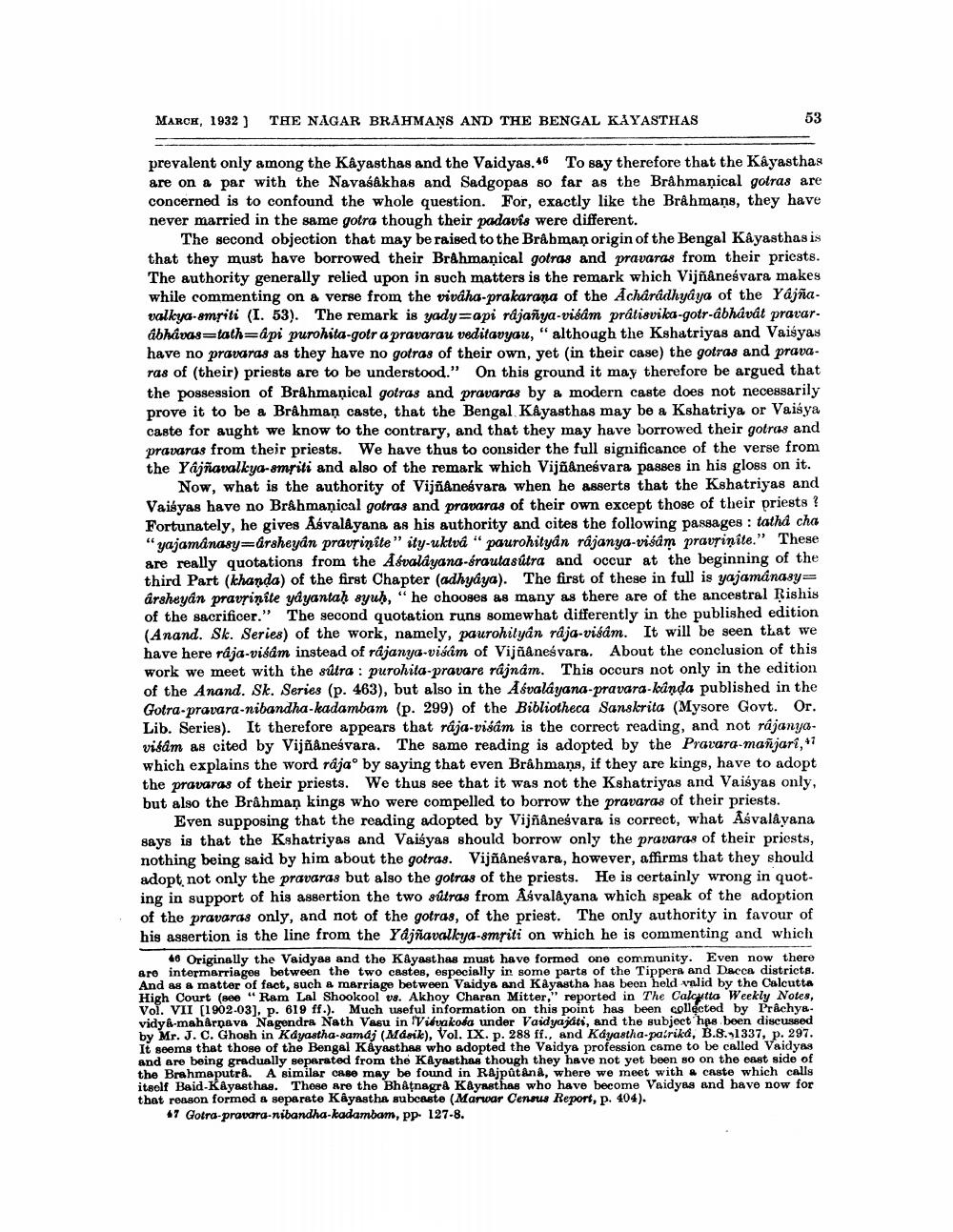________________
MARCH, 1932) THE NAGAR BRAHMANS AND THE BENGAL KAYASTHAS
53
prevalent only among the Kayasthas and the Vaidyas. 46 To say therefore that the Kayasthas are on & par with the Navasakhas and Sadgopas so far as the Brāhmaṇical gotras are concerned is to confound the whole question. For, exactly like the Brahmans, they have never married in the same gotra though their padavis were different.
The second objection that may be raised to the Bråbman origin of the Bengal Kayasthas is that they must have borrowed their Brahmaņical gotras and pravaras from their priests. The authority generally relied upon in such matters is the remark which Vijñânesvara makes while commenting on a verse from the vivaha-prakarana of the Acharadhyâya of the Yajñavalkya-smriti (I. 53). The remark is yady=api rajanya-visam prátisvika-gotr-ábhávat prararabhavas=tath=äpi purohita-gotr a pravarau veditavyau," although the Kshatriyas and Vaisyas have no pravaras as they have no gotras of their own, yet (in their case) the gotras and pravaras of (their) priests are to be understood.” On this ground it may therefore be argued that the possession of Brahmanical gotras and pravaras by a modern caste does not necessarily prove it to be a Brahman caste, that the Bengal Kayasthas may be a Kshatriya or Vaisya caste for aught we know to the contrary, and that they may have borrowed their gotras and pravaras from their priests. We have thus to consider the full significance of the verse from the Yajñavalkya-smriti and also of the remark which Vijñanesvara passes in his gloss on it.
Now, what is the authority of Vijñanesvara when he asserts that the Kshatriyas and Vaisyas have no Brahmaņical gotras and pravaras of their own except those of their priests ? Fortunately, he gives AsvalAyana as his authority and cites the following passages : tatha cha “yajamânasy=årsheyán pravrinite" ity-uktvá "paurohityán rajanya-visam pravrinite." These are really quotations from the Asvalayana-srautasútra and occur at the beginning of the third Part (kthanda) of the first Chapter (adhyaya). The first of these in full is yajamanasyårsheyan pravrinite yayantah syuh,"he chooses as many as there are of the ancestral Rishis of the sacrificer." The second quotation runs somewhat differently in the published edition (Anand. Sk. Series) of the work, namely, paurohityan raja-visam. It will be seen that we have here rája-visam instead of rajanya-visam of Vijñanesvara. About the conclusion of this work we meet with the sutra : purohita-pravare rájnam. This occurs not only in the edition of the Anand. Sk. Series (p. 463), but also in the Aśvalayana-pravara-kânda published in the Gotra pravara-nibandha-kadambam (p. 299) of the Bibliotheca Sanskrita (Mysore Govt. Or. Lib. Series). It therefore appears that rája-visam is the correct reading, and not rájanya. vitam as cited by Vijñâneśvara. The same reading is adopted by the Pracara-mañjari, *7 which explains the word råjao by saying that even Brâhmans, if they are kings, have to adopt the pravaras of their priests. We thus see that it was not the Kshatriyas and Vaisyas only, but also the Brahman kings who were compelled to borrow the pravaras of their priests.
Even supposing that the reading adopted by Vijñanešvara is correct, what Asvalâyana says is that the Kshatriyas and Vaisyas should borrow only the pravaras of their priests, nothing being said by him about the gotras. Vijñânesvara, however, affirms that they should adopt not only the pravaras but also the gotras of the priests. He is certainly wrong in quoting in support of his assertion the two sútras from Asvaldyana which speak of the adoption of the pravaras only, and not of the gotras, of the priest. The only authority in favour of his assertion is the line from the Yajñavalkya-smriti on which he is commenting and which
46 Originally the Vaidyas and the Kâyast has must have formed one community. Even now there Aro intermarriages between the two castes, especially in some parts of the Tippera and Dacca districts. And as a matter of fact, such a marriage between Vaidys and Kayastha has been held valid by the Calcutta High Court (see "Ram Lal Shookool v8. Akhoy Charan Mitter," reported in The Calcutta Weekly Notes, Vol. VII (1902-03), p. 619 ff.). Much useful information on this point has been collected by Prachys. vidy&-maharnava Nagendra Nath Vasu in IVidakoda under Vaidyajáti, and the subject has been discussed by Mr. J. C. Ghosh in Kdyaatha-samdj (Masik), Vol. IX. p. 288 ff., and Kdyastha-patrika, B.8. 1337, p. 297. It seems that those of the Bengal Kiyasthas who adopted the Vaidya profession came to be called Vaidyas and are being gradually separated from the Kayasthas though they have not yet been so on the east side of the Brahmaputra. A similar case may be found in Rajput &na, where we meet with a caste which calls itself Baid-Kayasthan. These are the Bhatnagrå Kåyasthas who have become Vaidyas and have now for that reason formed & separate Kayastha subcaste (Marwar Census Report, p. 404).
17 Gotra-pravara-nibandha-kadambam, pp. 127-8.




